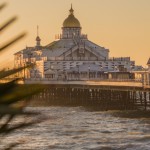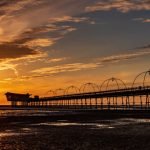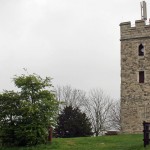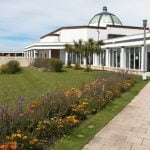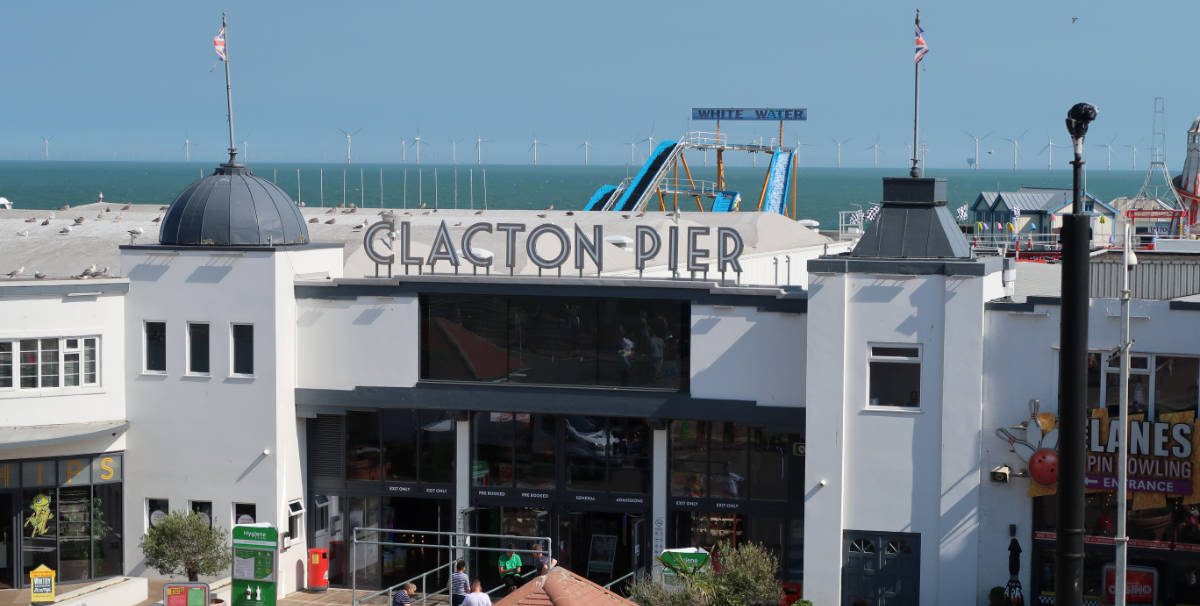
Clacton-on-Sea is just as described: it is a town on the sea, with its own nice beach and promenade. It has been a seaside destination of choice for many, at least since the late Victorian era, after the railway from London arrived. Today, Clacton has a large population of retired people, indicating that it is a place you retire to, rather than somewhere people come from.
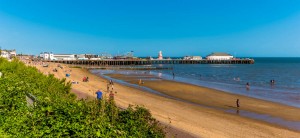
Image: By Nicola Pulham/Shutterstock.com
Join us today as we take a delve into the world of Clacton-on-Sea to find out what the best things are to do there, and to get the full story, of course.
Clacton-on-Sea Early History
Clacton-on-Sea found early fame during the Palaeolithic period… which is a long, long, long time ago. Several artefacts have been found in the area that proves it was a busy flint mine. In prehistoric times, flint was valuable because it was used to make everything from knives to fire. Flint mines would have been busy places, with communities growing up around them. In 1911, a yew spear was found in the area which was dated to 450k years ago. They estimate it is the oldest of its kind in Britain… and there might be more down there for all you keen archaeologists.
The production and mining of flint goods here was such a large pastime, that scientists named flint work from this time period as The Clactonian. In 2015, a Stone Age axe was found on the beach, which experts dated to 200k years old.
Skipping forward to the Bronze Age, a large selection of items has been found from the Beaker Bell culture. These people drank from inverted bells instead of cups and it is thought that they inhabited Britain from 2800 BC to 1800 BC. The range of people included was massive, with many different cultures using what became known as the Bell Beaker Culture. They lived to the south of Clacton-on-Sea.
There were also roundhouses to the north, which are estimated to be Celtic. They were probably built just before the Romans arrived. They are also estimated to belong to a nearby Celtic settlement as if the roundhouses were far off suburbs. Who knows? Maybe they were the holiday homes of the rich and famous of Celtic times?
Roman Clacton
The Romans were most certainly in the area. When they first crossed into Britain it would have been to the south of this area. Stone tools have been found here which dated to AD43-410, leading archaeologists to believe that at least some Romans lived or worked here. IT could have been a boatbuilding site given its proximity to the sea.
After the Romans left, Clacton-on-Sea was probably no more than a small fishing village. There is evidence of crops being grown nearby, but most of their sustenance likely came from fish. The town slowly grew for a few hundred years. Although we couldn’t find any reference of Vikings in the area online, we know that seaside towns were often attacked. Given that Clacton (great and little) was mentioned as one of the largest 20% of settlements in the Domesday Survey of 1086, we wouldn’t be surprised if it was ransacked at least once.
No more mention appears of this lovely town until that crucial Domesday mention. It is mentioned as having only a single owner, despite its large size. The land belonged to the Bishop of London, of St Paul’s. He owned 47 villagers, 95 smallholders, and 10 slaves. Let us never forget that the church kept slaves.
The land included 23 plough teams and 9 lord’s plough teams. It had 20 acres of meadow, woodland including 400 pigs, and pastureland with 141 sheep. It also had a mill, a fishery, 7 cattle, 30 pigs, and 41 sheep, under control. That’s a lot of value for one piece of land. It was worth 40 pounds to its lord… a sum fit for a king.
During the Napoleonic Wars, the government returned to Clacton-on-Sea again and again. They thought it was a possible invasion landing site and built an army base nearby to ensure it was protected.
Medieval Clacton-on-Sea
There aren’t many mentions of the town throughout the medieval period, which seems to indicate that it lessened in importance. The remains of a medieval parish and a cemetery have been uncovered in the area, telling us that some parishes were simply lost through time as the town’s population dwindled. The Parish lies under the junction of Hall Close and Frinton Road. It is safely in the hands of Historic England.
Another source tells the story of two stranded whales washing up on a gentleman’s manor in Clacton. Although whaling wasn’t common practice yet, the meat would not have gone to waste. When we researched this, we found that the Bishop of St Paul’s had been granted the rights to all ‘fat fish’ that were caught in the Tendring or in the sea around the town. He successfully claimed the two beached whales and sold their parts for the benefit of the church. 36 men were needed to carry the whale.
There is little else to say about Clacton in the Middle Ages. It stagnated under the church and would have done so until Henry VIII fell out with them circa 1539. We know that he closed down all the monasteries and the significance of the church dropped. Even though St Pauls in London was never closed down, the church would have been stripped of a great number of its lands.
Let’s take a break here, because Clacton really grew in the Victorian period, from the beginning of the 19th century onwards.
Fun Trivia about Clacton-on-Sea
We wouldn’t be Five minutes Spare if we weren’t intent on giving you some of the best fun facts about your local town. We dug up the funniest, most macabre, and coolest facts about Clacton, just for you. Here are some of our favourite fun facts:
- Clacton Pier was named ‘Pier of the Year’ in 2020. We’re not sure if that’s an achievement or not since 2020 was a write-off.
- Between the 1950s and the 1970s, Clacton was hailed as one of the most popular seaside resorts in the south of England.
- The name Clacton dates to Saxon times, roughly 500 AD after the Romans and before the Normans.
- Great Clacton was founded by the Celts in 100 AD and would later be the big town described in the Domesday Survey.
- Clacton-on-Sea has been voted the worst place to live by Essex Live. We don’t agree. If people retire to it, it’s probably sleepy, not boring.
Let’s stop there and jump back on to history. There’s still a lot to learn before we get to the attractions of Clacton-on-Sea.
Industrial Era Clacton and Onwards
The Clacton-on-Sea that we know and love today was founded in 1871 by a man named Peter Bruff. He wanted to develop a seaside resort, and Clacton was a good choice since it averaged only 20 inches of rain a year and 1,682 hours of sunshine. Bruff was a civil engineer, who had already played a large part in designing the extensive East Anglian railway networks. Bruff was also responsible for the Colchester piped water supply, and for the Ipswich sewerage system.
Together with William Jackson, a boat owner, Bruff built the pier at Clacton-on-Sea. They also erected the Royal Hotel on some nearby farmland, ready to welcome day-trippers from London. In 1872 the town was incorporated to allow it to flourish as a seaside resort. In 1882 the Great Eastern Railway arrived, and the pieces of land in town had been sold off to different developers.
By the start of the First World War, Clacton had 10,000 residents. It was said to be one of the largest seaside resorts between Southend and Great Yarmouth. It was a popular town for both those on day trips out of London City and for those looking for a few weeks holiday. Wealthy landowners would buy holiday houses there, ready to enjoy the beach.
2oth Century Clacton
As soon as Clacton was made into a seaside resort, it experienced a population boom. Even during the First World War, the town grew. The town gave 216 young men to the war effort, each of which is mentioned on the War Memorial in town. Nearly 8,000 young men from Essex were killed during that war.
When the first war was finished and the second was due to start, Clacton-on-Sea had doubled its population to 20,000 people. The Butlins holiday camp was opened in 1938, to accommodate all the holiday visitors that regularly flocked to this Victorian seaside town. Its perfect location on the sea and close to the capital made it ideal for holidaymaking. It was aimed at the lower and middle classes, although it still has richer areas, to this day.
During WWII, a German bomber had to bail out over the town. For three or four days, the German was treated like a local celebrity. Nobody knew what to do with him. He was eventually handed to the military. Later, only 8 months after the outbreak of the war, a Heinkel bomber crashed into the centre of town, killing two civilians and injuring 136 others. All four crew members were killed. It was a minelayer, so the blast must have been huge.
In 1941, Wagstaff Corner was bombed, destroying yet more buildings and homes. Clacton was hit again by a rocket, which destroyed a hotel in the area. The war memorial for WWII in Clacton reads 165 soldiers and 21 civilians.
Post War population boom
Since the war, modern Clacton-on-Sea has become a retirement village of sorts. From the 1950s to the 1970s, Clacton was one of the busiest holiday resorts in Britain. A local family bought a steam cruiser in the post-war years, running a cruise from there to London and back again. You could cruise to Calais in the 60s, too. In the same decade, the pier became famous for the battles between local mods and rockers. A pirate radio station was also run out of the area until ’67.
The ’70s saw the decline of the UK staycation industry, an industry that is currently experiencing a new wave of support. The rapid decline saw the area filled with empty accommodations which would later be demolished. Although still a seaside town, people would drive there for a day instead of staying there for a fortnight. Clacton-on-Sea became a town for retirees who had fond memories of spending their youth on the shores.
Modern-day Clacton is much the same. It is a day trip destination with long beaches and beautiful coastlines, which were recently cleaned up. In the 80s and 90s, the town experienced a growth surge as the retired population increased. Unemployment is high and an offshore wind farm has changed the view somewhat. However, Clacton-on-Sea is still the nostalgic haven that people who bathed in the sea in the 70s remember it as.
Let’s talk about the famous people who have come from this town before we move on to the best bits.
Famous People from Clacton-on-Sea
There has been a string of famous faces to have emerged from Clacton-on-Sea. Here are some of the Five Minute Spare favourites:
- Footballers Tom Eastman and Mike Everett.
- The English crime fiction writer Graham Hurley
- Saxophonist Davey Payne, for those that like jazz.
- Paul Banks, the lead singer of Interpol, is a Clacton man.
OK, so there aren’t very many famous people from Clacton-on-Sea to choose from, but you get the picture. Let’s move on to the bit everyone comes here for – the best things to see and do in Clacton-on-Sea.
Attractions in Clacton-on-Sea
Clacton-on-Sea has always been a holiday destination for those looking to take a break in the UK. We speculate that the next few years will see an increase in choice of staycation attractions in this sunny seaside town.
Historic Sights and Landmarks
One of the top attractions in town is the Princes Theatre. It has been operating for 90 years now, and not even Covid-19 was able to stop it. It holds around 250 events every year and can even be hired out for weddings. It holds nearly a thousand people, so book your show tickets before you leave.
If you don’t want the big seating and layout of the Prince’s Theatre, try the West Cliff Theatre, instead. It is a smaller, more traditional number that runs less frivolous shows. Don’t be mistaken though, you are bound to be able to catch a great pantomime.
Galleries and Museums
There are a couple of museums in the area. The East Essex Aviation Museum is perhaps the most popular. It allows people to learn about aviation and lets kids get up close and personal with some aircraft. The museum is in nearby St Osyth on Point Clear, but it is well worth the short drive to see it. It features the wreck and fuselage of a North American Mustang. It has been running since 1986.
For an alternative interactive experience, head out to Felixstowe and visit the Landguard Fort. Run by English Heritage, this huge fort was built to guard this area of coastline against invasion. First built in 1667, the Royal Marines stayed here in the 18th and 19th centuries.
If you want to know more about the local area, you want to visit the Clacton and District Local History Society Museum. This is where the collective history and artefacts found around town are kept. There is a lot of flints. Founded in 1987, this museum exists thanks to the local historical society, who got together to document the life and times of the town of Clacton-on-Sea. Go along and give generously, they need the donations to document events for future generations.
Outdoor Attractions
Obviously, the beach is the main event at Clacton-on-Sea. It is long enough to host thousands of visitors every year. It’s absolutely packed on busy summer days, especially in August. West Beach also has the pier attached, which has a few attractions of its own.
Clacton Pier has an amusement arcade where you can win all the teddies that you want to. It has a soft play area for the younger kids, which is open until 6. It has a Ferris wheel which gives you great views of the town, and an adventure golf section where you can play trick shots. There is a bowling centre and an arcade area, as well as a bar. There are rides and even a seaquarium area where the kids can look at sea animals.
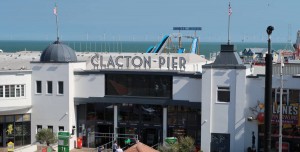
mage: Laurence Berger/Shutterstock.com
Visit Hasty’s Adventure Farm, which features a farm trail and a play zone for kids of all ages. They run parties and events and provide kids and adults with somewhere to have an adventure on any given weekend of the year. They have petting areas, feeding of the baby animals, and an adventure playground. Let’s not forget the café, either.
Not a museum or a gallery, but definitely a reflective area, you can sit in or walk through the Garden of Remembrance in Clacton-on-Sea. This well-kept garden allows you to buy a plaque for a loved one, who you would like to be remembered fondly. It’s a sweet area.
Sports and Recreation
Clacton-on-Sea features its own massive aqua park. The Curve Wake Park is a Wakeboarding area, where you can enjoy wakeboarding, kayaking and paddleboarding in a reasonably safe space. Another part is off the Pavilion on the seafront. In this area, there is a kid paddling pool that is safer for younger children. This area has a picnic table or two and allows kids to play in the water and on the slides in full few of anxious parents. It’s a good place to take kids who are too young for the sea just yet.
For golf, you can choose between the Clacton-in-Sea Golf Club and the Millers Barn Golf Park. Both will give you a good round or two.
You can follow the local team FC Clacton by visiting the stadium just to the west of town. You also have the Clacton Rugby Union FC in town, too.
Shopping and Retail
Clacton-on-Sea is known to be a good shopping area. For a day at the shops, visit the Clacton Shopping Village in the north endo f town. For a high-end experience, try the Waterglade Retail Park. Those who haven’t yet shopped enough will find more attractions in the Brook Retail Park.
Other Notable Attractions
They say there isn’t much to do in Clacton-on-Sea, but we beg to differ. We found so many worthwhile things to see and do in the area that we couldn’t fit them all in. Instead, we had to squeeze some things in at the end. Here are the things that didn’t quite make the list:
- Jawick beach is another firm favourite among locals.
- The Jawick Martello Tower is worth a visit.
- See the pavilion for yet more amusements and another bowling arcade.
- Take the youngest kids to Robbie Rascals Party and Play centre.
As you can see, there is something for everyone in or around Clacton-on-Sea. Go and visit, and don’t forget to report back to us if we missed something good.
How to get to Clacton-on-Sea
We wouldn’t be good guides if we didn’t tell you where you were going, would we? Here’s how to get to Clacton from London.
By Road
Follow the A12 past Colchester towards the coast.
By Rail
The Clacton-on-Sea train station is part of the Greater Anglia line.
By Air
The nearest airport is London Southend.
By Sea
Head for the port of Clacton-on-Sea.
Still, Browsing Staycations?
If you want to travel somewhere for a short break but you don’t want the hassle of flying, then we have reviewed loads of British staycation destinations for you to choose from. Have a browse through our travel pages or catch us on Instagram for more.
